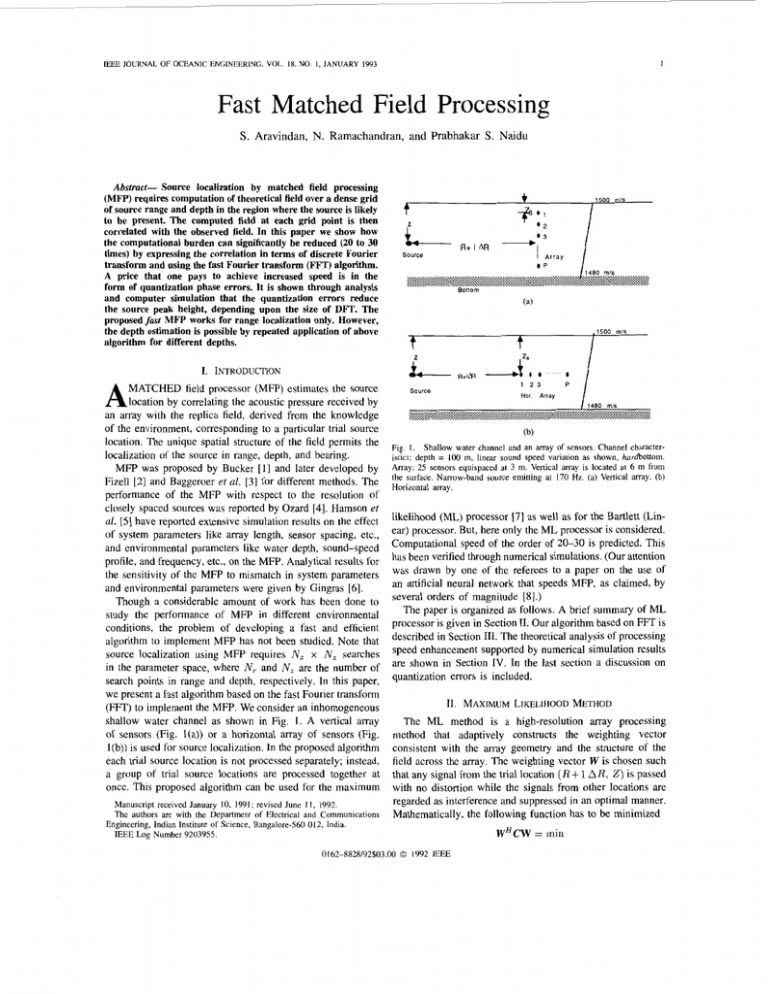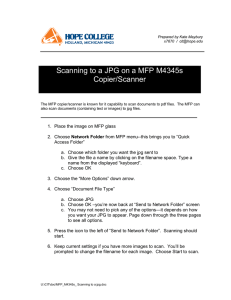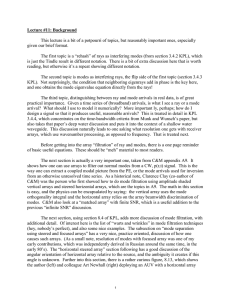Fast Matched Field Processing
advertisement

IEEE JOURNAL OF OCEANIC ENGINEERING, VOL. 18, NO. 1. JANUARY 1993
Fast Matched Field Processing
S. Aravindan, N. Ramachandran, and Prabhakar S. Naidu
Abstruct- Source localization by matched field processing
(MFP) requires computation of theoretical field over a dense grid
of source range and depth in the region where the source is likely
to be present. The computed field at each grid point is then
correlated with the observed field. In this paper we show how
the computational burden can significantly be reduced (20 to 30
times) by expressing the correlation in terms of discrete Fourier
transform and using the fast Fourier transform (FFT) algorithm.
A price that one pays to achieve increased speed is in the
form of quantization phase errors. It is shown through analysis
and computer simulation that the quantization errors reduce
the source peak height, depending upon the size of DFT. The
proposed fast MFP works for range localization only. However,
the depth estimation is possible by repeated application of above
algorithm for different depths.
a3
R+IAR
i Array
I P
Source
I
I
Bottom
(a)
t
,1500
I
t
mls
I. INTRODUCTION
A
MATCHED field processor (MFP) estimates the source
location by correlating the acoustic pressure received by
an array with the replica field, derived from the knowledge
of the environment, corresponding to a particular trial source
location. The unique spatial structure of the field permits the
localization of the source in range, depth, and bearing.
MFP was proposed by Bucker [ l ] and later developed by
Fizell 121 and Baggeroer et al. [3] for different methods. The
performance of the MFP with respect to the resolution of
closely spaced sources was reported by Ozard [4]. Hamson et
al. [5] have reported extensive simulation results on the effect
of system parameters like array length, sensor spacing, etc.,
and environmental parameters like water depth, sound-speed
profile, and frequency, etc., on the MFP. Analytical results for
the sensitivity of the MFP to mismatch in system parameters
and environmental parameters were given by Gingras [6].
Though a considerable amount of work has been done to
study the performance of MFP in different environmental
conditions, the problem of developing a fast and efficient
algorithm to implement MFP has not been studied. Note that
source localization using MFP requires N, x N , searches
in the parameter space, where N , and N , are the number of
search points in range and depth, respectively. In this paper,
we present a fast algorithm based on the fast Fourier transform
(FFT) to implement the MFP. We consider an inhomogeneous
shallow water channel as shown in Fig. 1. A vertical array
of sensors (Fig. l(a)) or a horizontal array of sensors (Fig.
1(b)) is used for source localization. In the proposed algorithm
each trial source location is not processed separately; instead,
a group of trial source locations are processed together at
once. This proposed algorithm can be used for the maximum
Manuscript received January IO, 1991; revised June 1 I , 1992.
The authors are with the Department of Electrical and Communications
Engineering, Indian Institute of Science, Bangalore-560 012, India.
IEEE Log Number 9203955.
Source
Hor.
Array
/
Fig. 1. Shallow water channel and an array of sensors. Channel characteristics: depth = I 0 0 m, linear sound speed variation as shown, hardbottom.
Array: 25 sensors equispaced at 3 m. Vertical array is located at 6 m from
the surface. Narrow-band source emitting at 170 Hz. (a) Vertical array. (b)
Horizontal array.
likelihood (ML) processor [7] as well as for the Bartlett (Linear) processor. But, here only the ML processor is considered.
Computational speed of the order of 20-30 is predicted. This
has been verified through numerical simulations. (Our attention
was drawn by one of the referees to a paper on the use of
an artificial neural network that speeds MFP, as claimed, by
several orders of magnitude [8].)
The paper is organized as follows. A brief summary of ML
processor is given in Section 11. Our algorithm based on FFT is
described in Section 111. The theoretical analysis of processing
speed enhancement supported by numerical simulation results
are shown in Section IV. In the last section a discussion on
quantization errors is included.
METHOD
11. MAXIMUMLIKELIHOOD
The ML method is a high-resolution array processing
method that adaptively constructs the weighting vector
consistent with the array geometry and the structure of the
field across the array. The weighting vector W is chosen such
that any signal from the trial location (RS1AR, 2 ) is passed
with no distortion while the signals from other locations are
regarded as interference and suppressed in an optimal manner.
Mathematically, the following function has to be minimized
0162-8828/92$03,00 0 1992 IEEE
W ~ C W= min
IEEE JOURNAL OF OCEANIC ENGINEERING, VOL. 18, NO. 1, JANUARY 1993
L
+
subject to the constraint
+
WHP(R 1 AR, 2 ) = 1
where C is the spectral matrix of the received field vector
and P(R 1 AR, 2 ) is the normalized replica field vector
and H stands for Hermitian transpose. The solution to this
optimization problem is obtained using the Lagrange multiplier
method [3] and is given by
+
W=
+
C - l P ( R 1 AR, 2 )
P H ( R+ 1 AR, Z ) C - l P ( R + 1 AR, 2 ) '
+
output for a trial location ( R 1 AR, 2). Since the strength
of the normalized replica field vector does not depend on the
trial source range (the normalization was done by dropping
d
m from the denominator in (2)), the range factor
has been removed from the above expression.
Next we shall show that the evaluation of above expression for the trial locations ( R ,Z), ( R + A R , Z ) , . - - , ( R +
LR AR, 2 ) is equivalent to finding the inverse Fourier transform of a sequence. Let
G(R+ 1 AR, 2 ) = EHC'E
1 = 0,1,. *
- ,LR
(4)
where LR is the number of search points in range. Approximating the phase terms in E by integral multiples of
2 n / N , assuming they are less than 2n, if not subtract integral
multiples of 2n and rearrange the vector E such that the phase
terms are in ascending order (corresponding changes will have
( 1 ) to be done to C' also), we get
The output of the processor for a trial location ( R 1 AR, Z )
is given by
SML(R
+ 1 AR, 2 )
-
1
+
P H ( R 1 AR, Z ) C - l P ( R + 1 AR, 2 ) '
The location of the source is given by the maximum of
SML(R 1 AR, Z ) , called here as parameter spectrum. This
is also known as ambiguity surface, e.g., in [2].
+
111. FASTMFP ALGORITHM
In the proposed method, the computation of MFP output
at different trial locations is modeled as a Fourier transform
problem and the FFT is used to speed up the processing. This
method is applicable to both horizontal and vertical arrays.
The acoustic pressure in a lossless waveguide at a sensor
i, which is at depth Zi, due to a trial source at location
( R 1 AR, 2 ) is given by [9, p. 911
+
where N , equal to 2 raised to an integer power, is a large
integer greater than LR and integers n; 5 N for all i.
By introducing zero rows and zero columns into C'
appropriately,G(R AR, 2 ) can be written as
+
G ( R + 1 AR, 2) = EHctE
= E"DE'
(6)
where
T
1
J
and D is a new N * N matrix obtained from C' by introducing
zero rows and zero columns so that the hermitian form in (6)
remains unchanged. Consider an example:
where c k and
are the kth mode horizontal wave number
and eigenfunction function, respectively, and M stands for
number of modes. The replica field vector at a vertical array
due to a source at ( R 1 AR, 2 ) can be written as
+
P(R+ 1 AR, 2 ) =
UE
diG-im
where U is a L x M matrix whose (ik)* element is given by
IC = 1, 2 , . . - , M
where L is the number of sensors, M is the number of
propagating modes in the channel, and
E = [,jEilAR
1
. ..
, ~ E M ~ ATR.
,
1
Substituting the above expression for the replica field vector
in the definition of the ML processor (l), we get
+
1
S M L ( R 1 AR, 2 ) = E~C'E
(3)
where C' = UHC-lU and C is the covariance matrix of
the received field. The above expression gives the processor
By actual evaluation of the above hermitian forms it can
be seen that the value remains independent of the term "a"
introduced in the vector e if we introduce a zero row and a zero
column as shown. Like C,the new matrix D is also Hermitian.
Writing (6) in full form we have
i=lm=l
For a Hermitian matrix D, performing the summation along
the diagonals of the matrix, it can be shown [lo], [ l l ] that
k=O
I
ARAVINDAN et al.: FAST MATCHED FIELD PROCESSING
3
where F ( k ) is expressible as a sum of diagonal elements of D .
For example, F ( 0 ) is the sum of the main diagonal elements
divided by two, F ( 1) is the sum of the elements of the first
diagonal above the main diagonal, F ( 2 ) is equal to the sum
of second main diagonal elements, and so on.
Thus with a single call to the FFT routine, the present
algorithm is able to compute the parameter spectrum at all locations, namely, ( R , Z ) , (R+AR. Z ) , . - . . ( R + L R A R , Z ) ,
for a fixed depth. By changing the value of R and 2,and
repeatedly applying this algorithm the entire region of interest
can be scanned.
The above development is also valid for a horizontal array
with a small change, namely in the computation of replica
vector. Let Sa be the distance of ith sensor from the reference sensor (sensor (#}l, see Fig. (l(b)). Then the acoustic
pressure at the ith sensor due to a trial source at a distance
R 1A R from the reference sensor and depth Z is given by
+
+
+
P(R 1AR S,, 2,2,)
M U, ( Z ) U K( ZJeJEn(R+lAR+Sz)
=E
M
J ~ , ( R+ 1A R )
assuming S,<<(R+ 1AR). The replica field vector at the
horizontal array can be written as
P ( R + 1AR, 2)M
where U is a matrix whose
(2,
UE
d
r
n
k)th element is given by
It may be noted that the above algorithm will work for
range localization and not for depth localization described in
[ 121. However, two-dimensional scan is possible by repeated
application of fast MFP.
IV. PROCESSING SPEED
In the proposed fast MFP, computation of the processor
output for a set of trial source locations is modeled as a
Fourier transform problem. Hence, we expect an improvement
in the processing speed inherent in all FFT-based processing
schemes. The ratio of the required number of complex multiplications in the conventional method, i.e., computing the
replica field for each trial location and then computing the
MRP output, to that infast MFP is given by
Speed Gain
M
3LM
(L2 + 3LM + 2L)LR
+ L M 2 + L 2 M + X L R log,
XLR
(9)
where z = N / L R is the ratio of the total number of IDFT
coefficients computed to the number of IDFT coefficients
actually used by this algorithm. Here, only the basic operations
are taken into account. In the numerator, a minimum of 3LM
to compute the replica field vector, (L2 L ) L R to evaluate the
hermitian form PHC-'P, and LLR to normalize the replica
+
10
30
20
40
NUMBEROF MODES
Fig. 2.
Speed gain as a function of number of modes (LR = 1000) for
channel shown in Fig. 1.
field. These estimates are based on [2, equations (3), (51,
and (22)]. Based on these equations a computer program was
written for evaluating the parameter spectrum. Some saving
in the number of operations can be made by exploiting the
structure of matrix P in (2) as a product of two matrices U and
E , of which U is a function of depth alone (and fixed range);
hence it need be evaluated only once. In the denominator,
M 2 L L 2 M to evaluate U H C P 1 U XLR
,
log, X L R for the
FFT, and 3LM to form the matrix U . Since the normalization
was done by simply dropping the denominator term in (2) no
computation was involved.
The expected gain in the processing speed is plotted in Fig.
(2) as a function of the number of propagating modes, M , in
the channel for different values of ~ ( L =
R 1000). The figure
shows that the expected gain in the processing speed increases
with the complexity of the field structure and decreases with
increasing value of 2. The physical significance of the value
of x will be made clear in the next section. Note that the
localization accuracy depends on the number of modes and
hence, the gain is related to the performance of the MFP.
A numerical simulation was carried out to confirm the predicted improvement in the processing speed. For the purpose
of simulation we have assumed N = 4096, S N R = 0 dB,
L R = 1000, and AR = 10 m. The processing speed gain
was measured by noting the CPU time required on Microvax
I1 (work station) by the conventional MFP and that required
by the fast MFT. The ratio of the CPU times is shown
in Fig. 3 along with the predicted result. The simulation
results generally agree with the predicted ones. The observed
differences are probably due to unaccounted operations in the
actual simulation. The gain in processing speed is generally
large when the channel is rich in modes, that is, for large M .
Note that this algorithm uses only the first L R IDFT
coefficients out of N computed coefficients. Since L R K N for
low quantization error, one can make use of a more efficient
FFT algorithm [ 131 to further improve upon the gain in the
processing speed. The algorithm does not require any extra
storage space since only nonzero elements of D and their
locations need to be stored.
+
Jck(R + 1A R + sa)
Uk(Z)Uk(Z,)eJEk(R+lAR+sz)
k=l
0
v.
EFFECTOF QUANTIZATION
ERROR
In the development offast MFP an approximation was made
in ( 5 ) , namely,
27r
(.iAR= -71;
N
+ti
(10)
4
[EEE JOURNAL OF OCEANIC ENGINEERING, VOL. 18, NO. 1, JANUARY 1993
16
m
, (a) FMFP
l2
.E 8
f
8'
9w
n
g:oo.
u)
sboo' 7b00'
9;100'11d00 ' , d o 0
000
16
'1$
5
15
10
25
20
.E
NUMBEROFMODES
f
8'
Fig. 3. Simulation results.
8
where IciI 5 7r/N is the quantization error. For an arbitrary
value of 1 the quantization error may be approximated by
27r
7r
5 I-.
(1 1)
N
From (11) we note that as 1 increases the quantization
error also increases. To keep the quantization error small the
maximum value of 1, namely LR,is chosen to be much smaller
than N . The quantization error introduces a random phase in
the expression for the replica field (2). Since in MFP the replica
field vector for different trial locations are matched with the
received field, fast MFP output is expected to be sensitive to
this quantization error.
The effect of phase quantization on the fast MFP output
(rather on the inverse of the output) is derived below. In (6)
we introduce the phase quantization error as modeled in (1 1)
G ( R + 1 A R , Z ) = EHCtE
(12)
where the quantization error in E is explicitly shown,
j j = [ei(EllAR-E1l), . . . >
,i(EMlAR--dMl)
I.
On expanding the hermitian form we obtain
i=l
i = l k=l
i#k
where ai = e j ( c i l A R - E t l ) .Now we model eil as a random variable which is uniformly distributed over a range,
f l ( 7 r l N ) . Taking the expected operation on both sides of
(13) we obtain
E{G(R
Range in rn
Fig. 4. Comparison of fast MFP (FMFP) and conventional MFP for two
different channels. (a) and (b) For hard bottom channel as shown in Fig. 1.
(c) and (d) For soft bottom, uniform sound speed (Pekeris) channel.
Z=O, 1, ~ , . . . , L R
(ilAR=-lni+Eil
N
XIEiEl
000
Range in m
+ 1 AR, 2 ) )
ifk
M
=(1-q2)CCli+v2G(R+1AR,
Z)
(14)
i=l
where ql = ( s i n ( l ( x / N ) ) / ( l ( r / N ) )The
) . first term on the
right-hand side of (14) is the error term caused by phase
quantization. For 1<N, that is, LR<N the error term will
be very small.
To study the effect of the quantization error on the fast
MFP output, the several simulations were performed. Two
uncorrelated sources (SNR = 0.0 dB) at same depth (50 m)
but at 6 km and 9 km range, respectively, were assumed.
Other parameters of the channel are as in Fig. 1. We have
applied both MFP and fast MFP to same covariance matrix
(assumed to be error free). Fig. 4(a) shows thefast MFP output
and Fig. 4(b) shows the MFP output. The source peaks are
correctly located. The source at 9 km appears to be attenuated
(about 2 dB) on account of quantization errors. However, the
sidelobe level is noticeably higher in the fast MFP output.
We have also considered a Pekeris channel (sound speed in
water = 1500 m/s and in sediment 1620 m/s and density
of water = 1 gm/cc and of sediment = 1.77 gm/cc) with
two sources at depth 50 m and range 6000 m and 9000 m,
respectively. The fast MFP output is shown in Fig. 4(c) and
that of MFP in Fig. 4(d). The sources are correctly located but
the character of the background is now totally different.
Further simulations were carried out to clearly bring out the
effects of the quantization error on the source peak height.
A source was successively placed at (3000, 50), (3020, 50)
(3040, 50), and so on. The power received at the array was
normalized for each source position so that the source peak
is expected to be same for all source locations. The fasf MFP
was used to compute the source peak and the largest sidelobe
for each position of the source. The results are shown in Fig.
5(a) for 0.0-dB SNR and in Fig. 5(b) for 10-dB SNR. We
note that the source peak height decreased with increasing
souce range, but the largest sidelobe level remained practically
unchanged. This pehnomenon was further studied in another
simulation using the same channel (Fig. I) but with positive
sound speed gradient, 1500 m/s to 1510 m/s. We have found
a similar behavior. From this one may conclude that the effect
of the quantization error is to reduce the source peak level; the
reduction depends on the value of 1 at the true source position.
From (14) we note that the inverse of the source peak in
ML spectrum is linearly dependent on { q } 2 .The verification
of this prediction is shown in Fig. 6. A least-squares fit is also
5
ARAVINDAN et ai.: FAST MATCHED FIELD PROCESSING
VI. CONCLUSION
RANGE in m.
A fast algorithm based on FFT has been developed to
implement the matched field algorithm (MFP) for localization
(range) of a sound source in a shallow water channel. We have
shown that the processing speed can be considerably improved
(20 to 30 times) at the expense of a slight reduction of the
source peak height. We have demonstrated both theoretically
and through numerical experiments that the effect of quantization is largely to reduce the source peak height, depending
upon the size of DFT.
Fig. 5. The effect of quantization on the source peak height as a
function1 A R for the channel shown in Fig. I . SNR=O.OO dB in (a) and 10 dB
in (b). The height of the largest sidelobe observed in the rangef2500 m from
the true source position is found to be unaffected by the quantization error.
REFERENCES
H. P. Bucker, “Use of calculated sound fields and matched field detection
Eta
+
Fig. 6. Inverse of source peak height is plotted against 17’ defined in (14).
The quantization noise model developed here predicts a linear relation (14)
between the inverse of source peak and 7’. This prediction is verified in the
above figure. A least-squares linear fit is also shown in the figure.
shown. Finally, we observe that the reduction of peak height
appears to be greater at higher SNR (10 dB) than at lower
SNR (0.0). Such a dependence of sensitivity on the SNR was
also noted by Gingras [6] for any mismatch between replica
field and received field.
The choice of z(= N I L E ) is based on the amount of
reduction in the source peak height in relation to sidelobe
height one is prepared to accept, keeping in mind the fact
that the speed gain depends on the value of z. In practical
applications, this algorithm should be applied in two steps.
First, apply this algorithm for a reasonably large value for
z to estimate the probable source locations. In the second
step, apply the algorithm selectively near each probable source
location, to confirm the presence of a source and to estimate
its power, taking an appropriate value of R such that the
value of 1 at each potential source location is so small that
the algorithm will give a reasonably accurate estimate of the
source peak.
to locate sound sources in shallow water,” J. Acoust. Soc. Am., vol. 59,
pp. 368-373, Feb. 1976.
R. G. Fizell, “Application of high resolution processing to range and
depth estimation using ambiguity surface,” J. Acoust. Soc. Am., vol. 82,
pp. 606-613, Aug. 1987.
A. B. Baggeroer, W. A. Kuperman, and H. Schmidt, “Matched field
processing: Source localization in correlated noise as a parameter
estimation problem,” J. Acoust. Soc. Am., vol. 83, pp. 571-587, Feb.
1988.
J. M. Ozard, “Matched field processing in shallow water for range, depth
and bearing determination: Results of experiment and simulation,” J.
Acoust. Soc. Am., vol. 86, pp. 744-753, Aug. 1989.
R. M. Hamson and R. M. Heitmeyer, “Environmental and system effects
on source localization in shallow water by MFP of a vertical array,” J.
Acoust. Soc. Am., vol. 86, pp. 195s1959, NOV. 1989.
D. F. Gingras, “Methods for predicting the sensitivity of MFP to
mismatch,” J. Acoust. Soc. Am., vol. 86, pp. 1940-1949, Nov. 1989.
J. Capon, “High resolution frequency-wavenumber spectrum analysis,”
Proc. IEEE, vol. 57, pp. 1408-1418, 1969.
J. M. Ozard, P. Zakarauskas, and P. W. KO, “Matched field Processing
using a neural network with preprocessing,” J. Acoust. Soc. Am. Suppl.
I , vol. 88, Fall 1990.
L. Brekhovskikh and Y. Lysanov, Fundamentals of Ocean Acoustics.
New York: Springer-Verlag, 1982.
A. M. Musicus, “Fast MLM power spectrum estimation from uniformly
spaced correlation,” IEEE Trans. Acoust. Speech, Signal Processing, vol.
33, 1985, pp. 1333-1335.
A. C. Monteiro, “Estimating the bearing of a moving source,” M.E.
dissertation, Dept. Elect. Comm., Eng. IISc, 1988.
T. C. Yang, “Modal shading coefficients for high resolution source depth
localization,” J. Acoust. Soc. Am., vol. 87, pp. 668-672, Feb. 1990.
J. D. Markel, “FFT pruning,” IEEE Trans, Audio Electro. Acous., vol.
AU-19, pp. 305-311, Dec. 1971.
S. Aravindan, photograph and biography not available at time of publication.
N. Ramachandran, photograph and biography not available at time of
publication.
Prabhakar S. Naidu, photograph and biography not available at time of
publication.






